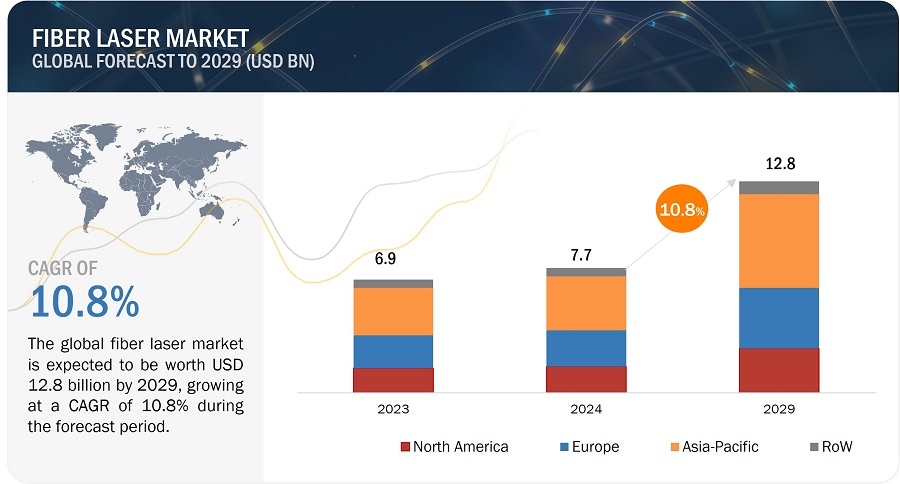The fiber lasers industry has witnessed remarkable growth over the past decade, revolutionizing various sectors such as manufacturing, telecommunications, medical technology, and defense. As we look ahead, several key trends are poised to shape the future of fiber lasers. This article explores predictions for the next decade, highlighting technological advancements, market dynamics, and evolving applications that will drive the fiber lasers industry forward.
The fiber laser industry to grow from USD 7.7 billion in 2024 and is expected to reach USD 12.8 billion by 2029, growing at a CAGR of 10.8% from 2024 to 2029. The key factors contributing to the growth of the fiber laser industry include the Industrial automation boosts fiber laser adoption for their precision, efficiency, and reliability, growing demand for fiber lasers in medical and healthcare industries, rising adoption of fiber lasers in consumer electronics, expansion of 3D printing and additive manufacturing. Fiber lasers offers high energy efficiency, low maintenance, and long lifespan
- Technological Advancements in fiber lasers industry
a. Increased Efficiency and Power
The demand for higher output power and efficiency in fiber lasers is expected to grow. Manufacturers are investing in research and development to enhance the performance of fiber lasers, including better thermal management and improved beam quality. These advancements will enable fiber lasers to handle more demanding applications, such as cutting thicker materials and achieving faster processing speeds.
b. Miniaturization and Portability
As industries strive for more compact solutions, the trend toward miniaturization of fiber laser systems will continue. Smaller, more portable units will become available, making fiber lasers more accessible for applications in tight spaces or remote locations. This trend will particularly benefit sectors like construction and field-based services.
c. Integration with Artificial Intelligence
The incorporation of artificial intelligence (AI) and machine learning into fiber laser systems will enhance their capabilities significantly. AI can optimize laser parameters in real time, improving precision and efficiency in cutting, welding, and engraving processes. Additionally, predictive maintenance powered by AI can minimize downtime by anticipating equipment failures before they occur.
Download PDF Brochure @ https://www.marketsandmarkets.com/pdfdownloadNew.asp?id=87036569

- Expanding Applications in fiber lasers industry
a. Medical Technology
The application of fiber lasers in the medical field is expected to grow substantially. From surgical procedures to dermatological treatments, fiber lasers provide precision and minimal invasiveness. Innovations in fiber optics will likely lead to more specialized medical applications, such as laser therapy for various conditions, including cancer treatment and cosmetic procedures.
b. Telecommunications
Fiber lasers are set to play a crucial role in the telecommunications sector, particularly in fiber optic communication systems. As the demand for faster internet speeds and higher bandwidth increases, fiber lasers will be essential in developing advanced communication networks. Innovations in wavelength division multiplexing (WDM) technology will further enhance data transmission capabilities.
c. Automotive and Aerospace
The automotive and aerospace industries are increasingly adopting fiber lasers for applications such as cutting, welding, and additive manufacturing. As these industries evolve toward lightweight materials and complex designs, fiber lasers will become essential for precise processing of materials like aluminum and titanium.
- Fiber Lasers Industry Dynamics
a. Growing Demand in Emerging Markets
The fiber lasers market is expected to see significant growth in emerging economies as industrialization and automation continue to rise. Countries in Asia-Pacific, particularly China and India, are investing heavily in manufacturing and infrastructure development, driving the demand for advanced laser technologies.
b. Sustainability and Eco-Friendly Practices
As environmental concerns gain prominence, the fiber lasers industry will focus on sustainability. Fiber lasers are generally more energy-efficient compared to traditional laser systems, and manufacturers will likely emphasize eco-friendly practices in their production processes. The ability to minimize waste and enhance energy efficiency will attract environmentally conscious industries.
c. Strategic Partnerships and Collaborations
To stay competitive, companies in the fiber lasers industry will increasingly pursue strategic partnerships and collaborations. Collaborations between manufacturers, technology providers, and research institutions can lead to innovative solutions and accelerated development of new applications. Such alliances will also enhance market reach and customer service.
- Challenges Ahead
a. Competition from Alternative Technologies
While fiber lasers are gaining popularity, they face competition from alternative technologies such as CO2 lasers and solid-state lasers. Manufacturers must continuously innovate to maintain their competitive edge and highlight the unique benefits of fiber lasers in various applications.
b. Skilled Workforce Shortage
The fiber lasers industry, like many advanced manufacturing sectors, may face challenges related to a shortage of skilled workers. As technology evolves, the need for highly trained personnel in laser operation, maintenance, and application development will become increasingly important. Companies will need to invest in training and education to address this gap.
The fiber lasers industry is poised for transformative growth in the next decade, driven by technological advancements, expanding applications, and evolving market dynamics. With increased efficiency, portability, and integration of AI, fiber lasers will continue to revolutionize manufacturing and other sectors. As the industry navigates challenges and embraces opportunities, it will play a critical role in shaping the future of various technologies, paving the way for innovative solutions that enhance productivity and sustainability. As we look to the future, the fiber lasers industry stands at the forefront of innovation, ready to meet the demands of an increasingly connected and automated world.

